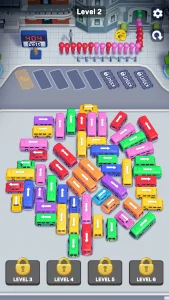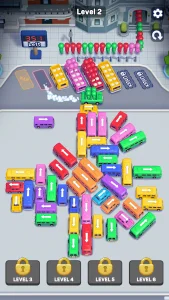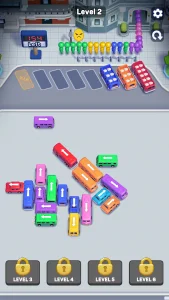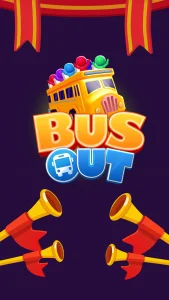Download Bus Out MOD Premium
*Bus Out* is a casual puzzle game developed by iKame Games – Zego Studio. The game’s core concept is a passenger-sorting and resource-management puzzle, rather than a simple traffic-unblocking game. Players must strategically manage a limited number of loading bays to move color-coded buses, load them with matching passengers from a queue, and dispatch them once their seating capacity is full. The primary challenge involves the efficient use of space to prevent gridlock and clear all passengers to complete a level.
Game Screenshots






What is Bus Out?
An Analytical Overview of Bus Out's Gameplay and Development
Bus Out, developed by the entity known as iKame Games - Zego Studio, presents itself within the hyper-casual market as a logic and puzzle game. Its core design is centered on a satisfying loop of sorting and traffic management, a formula that has secured millions of downloads across major mobile platforms. A comprehensive analysis of the game, however, reveals a significant conflict between its engaging mechanical foundation and its pervasive business model. The initial experience offers a relaxing puzzle, but the game's structure systematically transitions into a user-hostile monetization engine where progression is inextricably linked to advertising engagement and in-app purchases. This article provides a definitive examination of Bus Out's technical specifications, gameplay mechanics, and the economic framework that governs the entire player experience.Foundational Profile: Developer, Genre, and Platform Ecosystem
Corporate Structure and Publishing Entities
The corporate identity behind Bus Out is multifaceted, reflecting a sophisticated global operational strategy. On the Google Play store, the game is attributed to "iKame Games - Zego Studio," while on the Apple App Store, the legal publisher is listed as "Zego Global Pte Ltd." Third-party repositories often credit "Zego Studio" directly. This structure delineates specific corporate functions: Zego Global Pte Ltd, registered in Singapore, serves as the primary legal and financial entity, managing transactions and international compliance. Zego Studio, with a physical address in Hanoi, Vietnam, functions as the development center where the game's code and assets are created. The "iKame Global" brand represents the overarching publisher, which claims a portfolio of over 100 products and two billion total downloads, indicating that a large-scale, professional organization underpins the game's creation and distribution.Genre Classification and Core Mechanics
Bus Out is formally categorized as a Puzzle, Logic, and Casual game. Its gameplay is a hybrid that integrates elements from several popular sub-genres, including jam puzzle strategy, sorting games, and parking challenges. The primary activity involves matching color-coded passengers from a queue to their corresponding buses, which have limited seating capacity. This places the game firmly within the hyper-casual puzzle category, designed to appeal to players seeking a mentally stimulating yet low-stress activity. The marketing emphasizes a "Fun & Relaxing" experience, targeting a broad audience of casual gamers.Platform Availability and Technical Divergence
The title demonstrates broad platform availability, ensuring a wide market reach. Bus Out is available for Android devices via the Google Play Store and third-party APK providers, for iOS and iPadOS devices, for macOS systems equipped with an Apple M1 chip or later, and for Windows PC through the official Google Play Games emulator. A notable technical detail is the discrepancy in version numbers between platforms; the Android version (e.g., v1.231) is significantly higher than the iOS version (v1.87) despite concurrent update schedules. This divergence indicates that the Android and iOS builds are maintained on separate development tracks, which could result in platform-specific performance variations, bugs, or differences in level design and monetization prompts.Deconstructing the Core Gameplay Loop
The Primary Objective: Sorting Passengers and Managing Resources
Official descriptions market the game's objective as guiding buses out of a traffic jam, suggesting a spatial reasoning puzzle. However, this is a simplification of the true gameplay. The core mechanical loop is a passenger-sorting and resource-management challenge. Players are presented with a queue of colored passengers and a lot of matching buses. The process involves moving a bus into a limited number of loading bays, tapping the queue to load the correct passengers until the bus is full, and dispatching it. The departure of a full bus frees up both its original parking spot and, more importantly, the loading bay it occupied. The level is completed only when the entire passenger queue is cleared.Strategic Elements and Difficulty Scaling
The central strategic challenge in Bus Out revolves around the management of a single, critical resource: the loading bays. Players typically start with only four of these slots, and this number does not increase through normal gameplay. A single suboptimal move can create a gridlock state where no further actions are possible. For instance, occupying three bays with partially filled buses may prevent the player from accessing a needed fourth bus that is blocked in the parking lot. This dynamic forces players to plan several steps ahead, considering not just which passengers to load next, but also how to maintain an open loading bay to maneuver other vehicles. The game's difficulty does not scale with logical complexity but rather through the introduction of these artificial choke points, which are intentionally designed to be unsolvable without acquiring extra loading bays—a resource obtainable almost exclusively by watching advertisements or using premium currency.Analysis of In-Game Features and Functionality
Gameplay Modes and Visual Customization
The game is fundamentally a single-player experience. It incorporates a light social feature, "Compete with Friends," which allows players to compare their performance via leaderboards, adding a competitive element. To maintain visual interest, Bus Out includes a "Bus Out Around the World" theme. This feature introduces varied designs for the buses and backgrounds, representing different global locations and helping to mitigate visual monotony as players advance through hundreds of levels.The Misleading Nature of Offline Playability
On the Google Play Store, Bus Out is explicitly tagged as an "Offline" game, a highly sought-after feature for mobile players wishing to conserve data and avoid advertisements. However, the game's design creates a functional paradox. Progression is critically dependent on obtaining resources, such as extra parking spots, by watching rewarded video ads. User reports confirm that beyond the initial introductory stages, levels become practically unsolvable without these ad-gated resources. Therefore, while the application can technically be launched without an internet connection, its core progression loop is severed. This renders the "Offline" tag functionally misleading, as it creates a false expectation for users who download the game specifically to avoid its ad-based economy.The Monetization Engine: A Core Gameplay Component
In-App Purchases and Rewarded Advertisements
Bus Out is free to install but integrates a sophisticated monetization engine. Its in-app purchase catalog includes currency packs, starter bundles, and a "Remove Ads Pack" priced at a premium. However, the business model's foundation is its use of rewarded advertising. User feedback is overwhelmingly consistent in its assertion that the game is intentionally designed to be impossible to complete without watching ads. This issue arises very early, with players reporting that levels as low as 4 are designed to be impassable without the extra parking spot granted by viewing an ad. This transforms the game from a test of skill into a gate of patience or payment, where the player must choose between spending time watching an ad or spending money on currency. The most significant issue reported is the deceptive nature of the "Remove Ads Pack." This purchase only removes interstitial ads between levels; it does not remove the rewarded video ads required to obtain the resources essential for progression, failing to deliver the ad-free experience that the purchase implies.- The game's difficulty curve is engineered to create choke points that mandate watching rewarded ads to progress.
- The "Remove Ads" in-app purchase is widely reported as deceptive, as it fails to remove the rewarded ads that are integral to solving levels.
- Progression is less about logical deduction and more about a player's tolerance for ad-viewing or their willingness to make in-app purchases.
- Numerous technical complaints cite instances where watching a reward ad causes the game to restart without granting the promised resource, erasing progress.
APK Installation and Technical Considerations
Sourcing and Installing the Bus Out APK
For users who opt to install the game outside of the official Google Play Store, the application package can be found on reputable third-party repositories. The official package name for the Android version iscom.ig.bus.out, and verifying this identifier is a crucial step to avoid counterfeit applications. Downloads from these sources often come in the XAPK file format, an archive containing the base APK file along with supplementary OBB data files for graphics and media assets. This format cannot be handled by the default Android package installer and requires either a dedicated installer application or a manual process of renaming the file to .zip, extracting its contents, and manually placing the APK and OBB files in the correct system directories.
Permissions and Security Implications
The Bus Out application requests a high number of permissions—between 15 and 18—and its privacy policy states that user data may be shared with third parties. Given the significant user frustration with the game's business model, a primary motivation for seeking an APK is to find a modified version that removes ads or provides unlimited currency. While this is an understandable goal, installing unverified, modified application files from untrusted sources introduces severe security risks. Such files may contain embedded malware, spyware, or other malicious code designed to compromise the security of the user's device and personal information. Users should proceed with extreme caution and be fully aware of these potential dangers.Understanding the Core Gameplay of Bus Out
Bus Out presents a puzzle experience centered on passenger sorting and spatial resource management. The player’s primary objective involves clearing a queue of color-coded passengers by loading them onto correspondingly colored buses. Each level presents a parking lot with various buses and a limited number of loading bays. Success in the game requires players to develop a strategy for moving buses, loading passengers, and dispatching full vehicles in the correct sequence to avoid gridlock.
The game’s design merges elements of sorting puzzles with traffic management challenges. Players interact with the game by tapping on buses to move them into loading bays and tapping the passenger queue to load them. A bus automatically departs the level once its seating capacity is filled. The core challenge emerges from the finite number of loading bays, which act as the central resource that players must manage effectively to solve each puzzle.
The Foundational Mechanical Loop
Player progression in Bus Out is governed by a distinct and repetitive mechanical loop. Understanding this sequence is fundamental to mastering the game’s challenges. The process for clearing each level follows a structured pattern of assessment, execution, and resource cycling.
The Passenger Sorting and Dispatch Cycle
Each level’s puzzle is solved by executing a specific series of actions. This cycle forms the core gameplay and requires players to think several steps ahead to prevent irreversible errors. The typical gameplay sequence unfolds as follows:
- The player analyzes the incoming passenger queue to identify the sequence of colors.
- The player assesses the bus layout in the parking lot to determine which buses are accessible.
- The player selects a bus by tapping it, which moves the vehicle into an available loading bay.
- The player taps the passenger queue, and passengers of the matching color automatically board the selected bus.
- The bus remains in the loading bay until its seating capacity is completely filled.
- A full bus automatically dispatches, clearing its original parking spot and, crucially, freeing the loading bay it occupied.
- The player repeats this process, strategically selecting the next bus based on the passenger queue and available space.
This entire loop is performed without timers, positioning Bus Out within the casual puzzle genre. The difficulty originates not from time pressure but from the logical consequences of the player’s choices within a constrained environment.
Strategic Elements and Resource Management
While the core mechanics are simple, the strategic depth of Bus Out derives from the management of extremely limited space. The game’s level design intentionally creates situations where a single miscalculation can render a puzzle unsolvable without external resources or a level restart. The primary resource players must manage is not currency or power-ups, but the loading bays themselves.
The Critical Function of Loading Bays
Players typically begin with a small number of loading bays, a number which does not increase through standard level progression. Every bus must occupy one of these bays to be loaded. This system creates a significant strategic constraint. For example, if a player moves three different buses into three of four available bays to partially load them, they severely limit their future options. If the next passengers in the queue require a fourth bus that is blocked in the parking lot, the player cannot free that bus. Freeing the required bus would necessitate moving the blocking bus into an empty loading bay, but all available bays are already occupied. This state of gridlock is a common failure condition.
Difficulty Scaling Through Artificial Constraints
The game’s difficulty curve is not primarily based on increasing logical complexity. Instead, progression is challenged by level designs that are mathematically unsolvable with the initial set of loading bays. Certain levels are intentionally designed to function as choke points. These puzzles present passenger and bus layouts that force the player into a gridlock state. The only way to resolve these situations is to acquire an additional, temporary loading bay. This resource is not earned through skillful play but is offered in exchange for watching a rewarded video advertisement. This design choice transforms the gameplay from a pure logic puzzle into a resource-gated progression system, where player advancement becomes dependent on interaction with the game’s monetization mechanics.
Effective Gameplay Strategies and Tips
To progress in Bus Out, players must adopt strategies that mitigate the constraints imposed by the level design. Effective play involves careful planning, resource conservation, and an understanding of how the game’s systems create challenges. The following tactics can improve a player’s performance and reduce the need to rely on external resources.
A Guide to Strategic Play
Maximizing efficiency and avoiding gridlock are the keys to solving the puzzles in Bus Out. Players should focus on long-term planning rather than immediate moves. Adhering to a disciplined approach can help overcome many of the game’s built-in challenges.
- Maintain an Open Loading Bay: Players should always strive to keep at least one loading bay free. This open slot acts as a crucial maneuvering space, allowing the player to move a blocking bus out of the way to access a needed one.
- Prioritize a Single Bus: Players should resist the temptation to partially fill multiple buses at once. This action quickly occupies loading bays and leads to gridlock. The optimal strategy involves focusing on filling and dispatching one bus completely before moving to the next.
- Analyze the Full Passenger Queue: Before moving any bus, players must examine the visible passenger queue. This analysis informs which bus to prioritize and helps the player anticipate future moves, preventing them from calling a bus forward that cannot be filled soon.
- Understand the Role of Ads: Players must recognize that certain levels, particularly those cited as progression walls like Level 4 or Level 55, are designed to be nearly impossible without an extra parking slot. The primary mechanic to acquire this slot is the rewarded advertisement. Therefore, interacting with this system becomes a part of the strategic gameplay loop for progression.
Offline Playability Considerations
The game is designated as playable offline, which typically suggests an ability to bypass ad-based mechanics. However, this feature presents a functional paradox in Bus Out. While the game can be opened and played without an internet connection, the core progression is critically dependent on the rewards from online advertisements, namely the extra loading bays. Playing in offline mode effectively severs the player’s access to the primary tool needed to overcome the game’s artificial choke points. This makes progression beyond the initial introductory levels practically impossible, invalidating the offline mode as a viable strategy for an uninterrupted experience.
